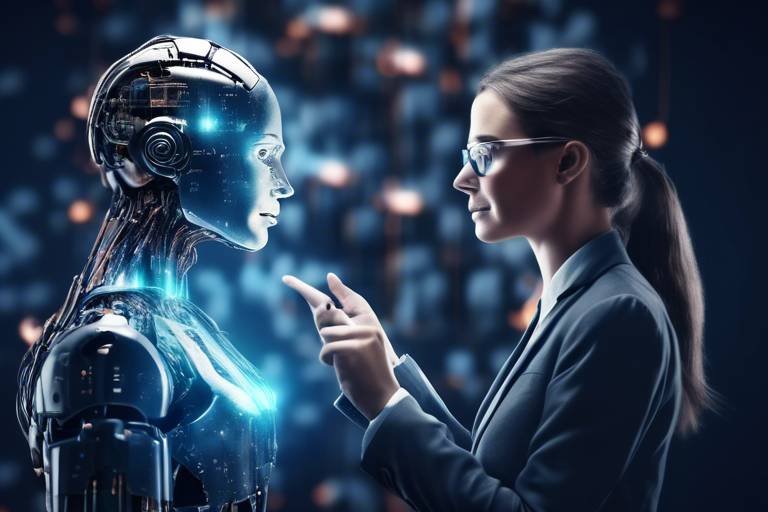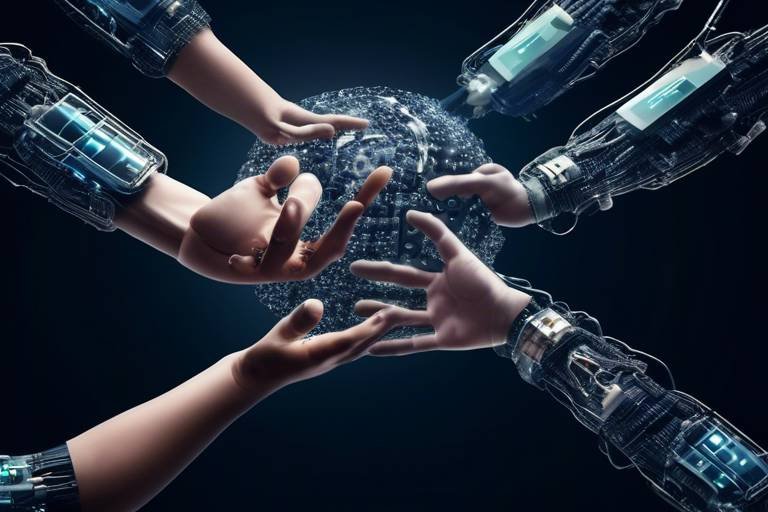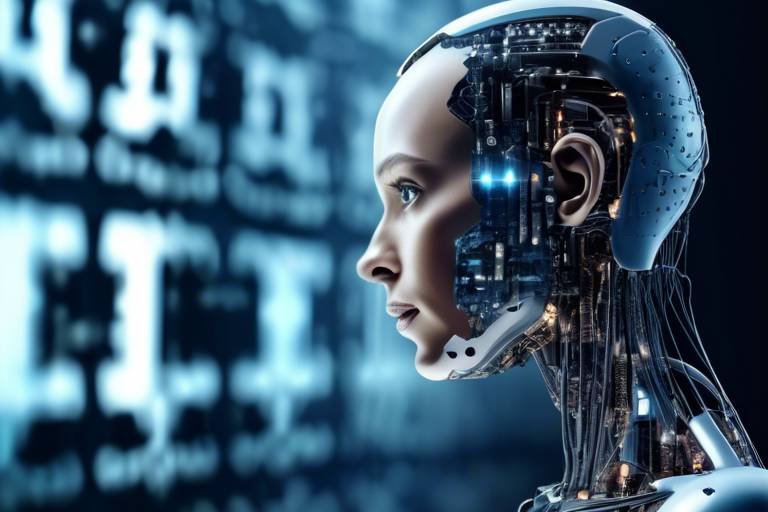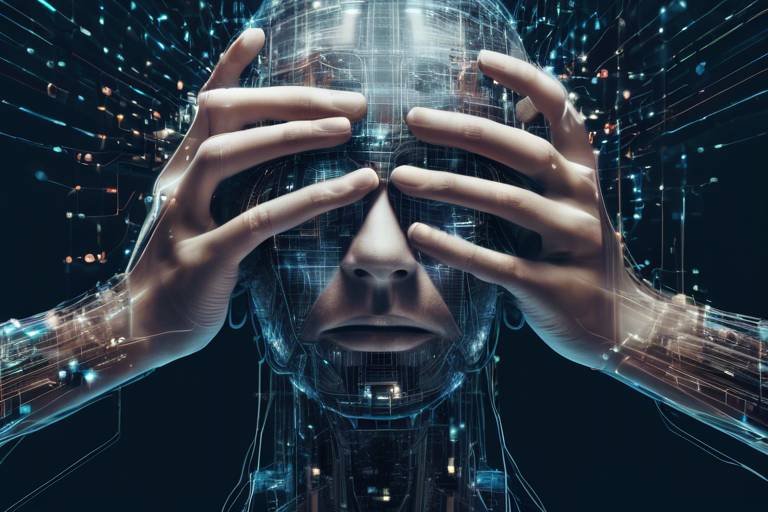Teamwork in the AI Era: A Look into the Future of Collaboration
In today's rapidly evolving landscape, the integration of artificial intelligence (AI) into the workplace is not just a trend; it's a revolution. As we navigate this new terrain, the dynamics of teamwork are being reshaped in ways we never thought possible. Imagine a world where tedious tasks are handled by machines, freeing up human minds to focus on creativity and innovation. This is not science fiction—this is the reality of the AI era. But what does this mean for how we collaborate? Are we ready to embrace these changes, or will we cling to outdated methods? In this article, we’ll dive deep into how AI is transforming teamwork, enhancing collaboration, and ultimately shaping the future of work.
Artificial intelligence tools are revolutionizing how teams collaborate by streamlining communication and automating mundane tasks. Picture this: instead of spending hours sifting through emails or organizing schedules, team members can now focus on strategic initiatives and creative problem-solving. AI-powered platforms can analyze data, predict project outcomes, and even suggest the best times for meetings based on team availability. This not only boosts productivity but also enhances the quality of collaboration. Teams can now work smarter, not harder, thanks to AI. However, the journey to fully harnessing AI’s potential isn’t without its bumps in the road.
While AI offers numerous benefits, its integration into teamwork comes with challenges. One of the most significant hurdles is the resistance to change. Many team members may feel apprehensive about adopting new technologies, fearing that their roles might become obsolete. Additionally, the need for training to effectively use AI tools can be daunting. Concerns about job displacement can create a cloud of uncertainty over the entire team, making it crucial to address these fears head-on.
Addressing the fears and misconceptions surrounding AI is crucial for successful adoption. Open and transparent communication is key. Team leaders should share success stories and demonstrate how AI can enhance team performance rather than replace it. This can be achieved through:
- Workshops that showcase AI capabilities
- Regular updates on AI integration progress
- Encouraging feedback and discussions about AI tools
When team members see the tangible benefits of AI in their daily tasks, they're more likely to embrace the change.
Investing in training programs is essential for equipping team members with the necessary skills to utilize AI tools effectively. Think of it as giving your team a new set of tools for their toolbox. A culture of continuous learning and adaptation is vital in this AI-driven world. Training can include:
- Hands-on workshops
- Online courses on AI applications
- Mentorship programs
By fostering an environment where learning is encouraged, teams can evolve alongside technology.
Establishing trust in AI systems is paramount. Transparency in how decisions are made can help teams feel more comfortable relying on AI for collaboration and decision-making. For instance, sharing the algorithms and data sources used in AI tools can demystify the technology and build confidence among team members. When teams understand how AI works, they’re more likely to trust its outcomes.
As AI takes on routine tasks, team roles are naturally evolving. Members must adapt to new responsibilities that emphasize creativity, critical thinking, and emotional intelligence. This shift is reshaping team dynamics, creating a landscape where human skills complement AI efficiency. The key is to embrace these changes rather than resist them, as the future of teamwork lies in collaboration between humans and machines.
AI is playing a pivotal role in remote collaboration, enabling teams to work effectively across distances. Enhanced communication tools and virtual environments are mimicking in-person interactions, making it easier for teams to stay connected. Imagine being able to brainstorm ideas in a virtual room that feels just as engaging as a physical meeting space. This is the future of remote teamwork, and it's exciting!
Emerging technologies like Virtual Reality (VR) and Augmented Reality (AR) are transforming remote teamwork by creating immersive environments for collaboration. These technologies allow teams to engage in more interactive and engaging ways. Imagine donning a VR headset and collaborating with your colleagues in a digital space that feels like a real office. This level of engagement can significantly enhance creativity and innovation.
To maximize the effectiveness of remote teams in the AI era, implementing best practices is crucial. Regular check-ins can keep everyone aligned, while leveraging AI analytics for performance tracking can provide insights into team dynamics. Additionally, fostering a supportive culture where team members feel valued and heard can significantly enhance collaboration. Remember, a happy team is a productive team!
Q: How can AI improve team communication?
A: AI tools can streamline communication by automating scheduling, summarizing meetings, and providing real-time updates, allowing team members to focus on more strategic discussions.
Q: Will AI replace human jobs in teams?
A: While AI can automate routine tasks, it is designed to complement human skills, not replace them. Team members will take on new roles that require creativity and emotional intelligence.
Q: What training is needed for teams to adapt to AI?
A: Teams should engage in training programs that cover AI tools, applications, and best practices to ensure they are equipped to utilize technology effectively.
Q: How does AI affect remote teamwork?
A: AI enhances remote teamwork by providing tools that facilitate communication, collaboration, and project management, making it easier for dispersed teams to work together effectively.

The Role of AI in Enhancing Team Collaboration
Artificial intelligence (AI) is not just a buzzword; it's a game-changer in how teams collaborate and work together. Imagine a world where tedious tasks are handled by machines, allowing human team members to focus on what they do best—innovating and problem-solving. AI tools are revolutionizing teamwork by streamlining communication, automating mundane tasks, and providing insights that drive strategic initiatives. This transformation is akin to having a super-efficient assistant who never sleeps and always has your back!
One of the most significant advantages of AI in teamwork is its ability to enhance communication. AI-powered chatbots and virtual assistants can manage scheduling, answer common queries, and even facilitate meetings by finding the best times for everyone involved. This not only saves time but also reduces the friction often associated with coordinating schedules. With AI taking care of the logistics, team members can spend more time brainstorming ideas and less time playing email tag.
Moreover, AI can analyze vast amounts of data and provide valuable insights that help teams make informed decisions. For instance, AI tools can assess project performance metrics, identify bottlenecks, and suggest actionable steps to improve workflow. Imagine having a crystal ball that not only predicts outcomes but also provides a roadmap to success! This level of insight empowers teams to pivot quickly and adapt to changing circumstances, making them more agile and responsive.
However, the role of AI in enhancing collaboration goes beyond just efficiency and data analysis. It also fosters a more inclusive environment. AI tools can help bridge communication gaps in diverse teams by offering real-time translation services, ensuring that language barriers don't hinder collaboration. This inclusivity can lead to richer discussions and more innovative solutions, as varied perspectives come together seamlessly.
To illustrate the impact of AI on teamwork, consider the following table that highlights key AI tools and their benefits:
| AI Tool | Benefit |
|---|---|
| AI-Powered Chatbots | Streamline communication and manage inquiries efficiently. |
| Project Management Software | Analyze performance metrics and identify bottlenecks. |
| Real-Time Translation Services | Facilitate communication in diverse teams. |
| Sentiment Analysis Tools | Gauge team morale and improve workplace culture. |
In conclusion, AI is not just enhancing team collaboration; it's redefining it. By taking over mundane tasks, providing valuable insights, and fostering inclusivity, AI empowers teams to collaborate more effectively than ever before. As we embrace this technological revolution, the future of teamwork looks brighter and more promising, filled with endless possibilities for innovation and creativity.
- How does AI improve team communication? AI tools streamline communication by managing schedules, answering queries, and facilitating meetings efficiently.
- Can AI help in decision-making? Yes, AI analyzes data and provides insights that help teams make informed decisions quickly.
- What role does AI play in diverse teams? AI offers real-time translation services, ensuring that language barriers do not hinder collaboration.
- Are there any downsides to using AI in teamwork? While AI offers many benefits, challenges like resistance to change and the need for training can arise.

Challenges of AI Integration in Teams
As we dive deeper into the AI era, one of the most pressing issues teams face is the integration of artificial intelligence into their workflows. While the advantages of AI are numerous and impactful, the road to successful integration is often paved with challenges that can hinder progress. First and foremost, there is the resistance to change. Many team members may feel apprehensive about adopting new technologies, fearing that AI could disrupt their established routines or even threaten their job security. This fear can create a significant barrier to embracing AI tools, leading to skepticism and reluctance among team members.
Moreover, the integration of AI requires a certain level of training and upskilling. Not everyone is well-versed in the latest technologies, and without proper training, team members may struggle to understand or effectively utilize AI tools. This gap in knowledge can lead to frustration and inefficiency, ultimately impacting team performance. Additionally, organizations need to invest time and resources into comprehensive training programs that cater to different skill levels, which can be a daunting task.
Another challenge lies in the concerns about job displacement. The fear that AI will replace human jobs is prevalent and can lead to a lack of trust in AI systems. Team members may worry that their roles could become obsolete, leading to anxiety and decreased morale. To combat this, it is essential for leaders to communicate the value of AI as a tool that enhances human capabilities rather than replaces them. This shift in perspective can help alleviate fears and foster a more positive outlook towards AI integration.
Furthermore, the cultural shift that comes with AI adoption can be daunting. Teams may need to redefine their dynamics and workflows, which can lead to confusion and resistance. To navigate this transition smoothly, organizations must prioritize open lines of communication and actively involve team members in the process, ensuring that everyone feels included and valued. By addressing these challenges head-on, teams can pave the way for a more collaborative and innovative future.
- What are the primary challenges of integrating AI into teams? The main challenges include resistance to change, the need for training, and concerns about job displacement.
- How can organizations overcome resistance to AI adoption? Transparent communication and demonstrating AI's value can help in overcoming resistance.
- Is training necessary for effective AI integration? Yes, investing in training programs is crucial to equip team members with the skills needed to utilize AI tools effectively.
- How can trust in AI systems be built? Establishing transparency in decision-making processes can help teams feel more comfortable relying on AI.

Overcoming Resistance to AI Adoption
Every time a new technology emerges, there’s a wave of excitement, but also a cloud of skepticism. Artificial Intelligence (AI) is no different. Many team members may feel threatened by AI, fearing that it could replace their jobs or diminish their roles within the organization. To combat this resistance, it's essential to understand that AI is not here to take away jobs; rather, it’s designed to enhance our capabilities and make our work more efficient. Imagine AI as a helpful assistant, one that handles the mundane tasks, allowing you to focus on what truly matters—creativity and innovation.
To successfully overcome the barriers of resistance, organizations must adopt a multifaceted approach. First and foremost, transparent communication is key. It’s vital to engage in open dialogues with team members, addressing their concerns head-on. This could involve hosting workshops or Q&A sessions where employees can express their worries and get informed about how AI can be a valuable tool rather than a competitor. When individuals understand the benefits of AI, they are more likely to embrace it.
Another effective strategy is to showcase real-life examples of how AI has positively impacted teams. By sharing success stories, organizations can illustrate the tangible benefits of AI integration. For instance, consider a marketing team that utilized AI-driven analytics to streamline their campaigns. By automating data collection and analysis, team members were able to focus on crafting creative strategies that resonated with their audience, ultimately leading to increased engagement and sales.
Furthermore, providing training programs tailored to the specific AI tools being implemented can significantly reduce anxiety. When team members feel equipped to use new technologies, they are more likely to adopt them enthusiastically. Training should not be a one-time event; instead, it should foster a culture of continuous learning. This could include regular workshops, online courses, and collaborative projects that encourage team members to explore AI capabilities together.
Lastly, it’s essential to build trust in AI systems. Trust is the foundation of any successful team, and this extends to the tools they use. Organizations should ensure that AI systems are transparent in their operations. For example, when an AI tool makes recommendations, it should provide clear explanations of how those conclusions were reached. This transparency can alleviate fears and help teams feel more comfortable relying on AI for collaboration and decision-making.
In summary, overcoming resistance to AI adoption is a journey that requires patience, understanding, and strategic efforts. By fostering a culture of open communication, showcasing success stories, providing comprehensive training, and building trust, organizations can pave the way for a smooth transition into an AI-enhanced future.
- What are the main benefits of AI in teamwork? AI enhances collaboration by automating routine tasks, streamlining communication, and providing valuable insights that help teams make informed decisions.
- How can I address my team's concerns about AI? Open communication, transparency, and demonstrating the benefits of AI through real-life examples can help alleviate fears.
- What kind of training is necessary for AI adoption? Training should focus on familiarizing team members with the specific AI tools being utilized, emphasizing hands-on practice and continuous learning.
- How can we build trust in AI systems? Ensuring transparency in how AI makes decisions and providing clear explanations can help build trust among team members.

Training and Skill Development
In today's fast-paced world, where artificial intelligence is rapidly reshaping the workplace, have become more crucial than ever. As AI tools are integrated into teams, it's vital that team members are not only aware of these technologies but also proficient in using them. Imagine trying to navigate a high-tech spaceship without understanding how the controls work; that's what it feels like for employees who are thrust into an AI-driven environment without proper training. Therefore, investing in comprehensive training programs is essential.
These programs should not only cover the technical aspects of AI tools but also emphasize soft skills that are increasingly important in this new landscape. Skills such as creativity, critical thinking, and emotional intelligence are becoming the cornerstones of effective teamwork. For instance, while AI can analyze data and provide insights, it takes human intuition and creativity to interpret those insights and make informed decisions. Thus, a well-rounded training program should include:
- Technical Training: Hands-on experience with AI tools and software.
- Soft Skills Development: Workshops on communication, teamwork, and emotional intelligence.
- Continuous Learning: Encouraging a mindset of ongoing education to keep pace with technological advancements.
Moreover, creating a culture of continuous learning within teams can significantly enhance adaptability. When team members feel supported in their professional development, they are more likely to embrace AI as a tool that augments their capabilities rather than as a threat to their jobs. This cultural shift can be fostered through mentorship programs, peer learning sessions, and even informal knowledge-sharing platforms where team members can showcase their newfound skills.
Additionally, organizations should consider implementing feedback loops where employees can voice their challenges and suggestions regarding AI tools. By doing so, they not only empower their teams but also gain valuable insights into how these tools can be improved for better usability. After all, the goal is to create a seamless integration of AI into the workflow, enhancing productivity without causing disruption.
Finally, it's essential to recognize that training is not a one-time event but an ongoing process. As AI technology evolves, so too must the skills of the workforce. Regularly updating training materials and programs to reflect the latest advancements in AI will ensure that teams remain competitive and capable of leveraging these powerful tools effectively.
Q1: Why is training necessary for AI integration in teams?
A1: Training is crucial to ensure that team members are proficient in using AI tools, which enhances productivity and fosters a culture of continuous learning.
Q2: What skills should be prioritized in training programs?
A2: Both technical skills related to AI tools and soft skills such as creativity, critical thinking, and emotional intelligence should be prioritized.
Q3: How can organizations encourage a culture of continuous learning?
A3: Organizations can promote continuous learning by offering mentorship programs, peer learning sessions, and creating platforms for knowledge sharing.
Q4: Is training a one-time process?
A4: No, training should be an ongoing process to keep up with the evolving AI technologies and ensure that teams remain competitive.

Building Trust in AI Systems
Establishing trust in AI systems is not just a technical challenge; it’s a human one. As teams increasingly rely on AI for collaboration and decision-making, it's essential that members feel confident in these tools. Trust is built on a foundation of transparency, reliability, and understanding. When team members comprehend how AI makes decisions, they are more likely to embrace its capabilities rather than fear them. Imagine AI as a new team member who needs to prove their worth; just like any other colleague, AI must demonstrate its value through consistent and reliable performance.
One of the most effective ways to foster trust is through transparent communication. This means openly discussing how AI algorithms function, the data they use, and the rationale behind their recommendations. For instance, if an AI tool suggests a specific strategy for a project, teams should understand the data and logic that led to that suggestion. This kind of transparency can significantly reduce skepticism and build confidence among team members.
Moreover, it’s crucial to involve team members in the AI integration process. When individuals participate in the development and implementation of AI tools, they gain firsthand experience and insights, which can demystify the technology. Workshops, training sessions, and collaborative discussions can serve as platforms for team members to express their concerns and ask questions. By addressing these inquiries openly, organizations can create a culture of trust that encourages team members to rely on AI as a valuable resource.
Additionally, organizations should focus on user-friendly interfaces and intuitive designs for AI systems. If team members find AI tools easy to use, they are more likely to trust them. Complex systems that require extensive training can lead to frustration and resistance. Therefore, investing in user experience design is crucial for enhancing trust. A well-designed AI tool feels less like a black box and more like a collaborative partner.
Ultimately, building trust in AI systems is an ongoing process that requires commitment from both leadership and team members. Regular feedback loops can help organizations understand how well AI tools are meeting team needs and where improvements are necessary. By fostering an environment of continuous improvement, teams can ensure that AI remains a trusted ally in their collaborative efforts.
- What is the importance of trust in AI systems? Trust is essential for effective collaboration, as it encourages team members to rely on AI for decision-making and enhances overall productivity.
- How can organizations promote transparency in AI? Organizations can promote transparency by openly discussing how AI algorithms work, the data they use, and involving team members in the integration process.
- What role does user experience play in building trust? A user-friendly interface helps team members feel more comfortable using AI tools, which fosters trust and reduces resistance.
- How can feedback loops improve AI integration? Regular feedback allows organizations to understand team needs and continuously improve AI tools, ensuring they remain effective and trusted resources.

Redefining Team Roles in an AI-Driven Environment
As we navigate through the exciting yet challenging landscape of an AI-driven workplace, it becomes increasingly clear that the roles within teams are undergoing a significant transformation. Gone are the days when team members were primarily tasked with routine, repetitive jobs. With AI stepping in to handle these mundane tasks, team roles are evolving to emphasize creativity, critical thinking, and emotional intelligence. This shift not only reshapes individual responsibilities but also alters the very dynamics of teamwork.
Imagine a scenario where a team member no longer spends hours sifting through data to find insights. Instead, AI tools do the heavy lifting, allowing that individual to focus on interpreting those insights and crafting innovative strategies. This transition encourages team members to become more proactive and strategic in their roles, fostering an environment where collaboration is driven by human creativity and machine efficiency. It’s like turning a traditional orchestra into a jazz band, where improvisation and adaptability take center stage.
However, redefining team roles isn't just about shifting responsibilities; it's also about embracing new skills. Team members must now cultivate a deeper understanding of AI tools and how they can complement their work. For instance, a marketing professional might need to learn how to leverage AI analytics to better understand customer behavior, while a project manager could benefit from mastering AI-driven project management software. The key here is to foster a culture of continuous learning, where team members are encouraged to upskill and adapt to the changing landscape.
Moreover, the integration of AI into teamwork necessitates a reevaluation of leadership roles as well. Leaders must become facilitators of this transition, guiding their teams through the complexities of AI adoption. They should focus on creating an environment that encourages open communication and collaboration, where team members feel comfortable sharing their insights and concerns about AI. This approach not only builds trust but also ensures that everyone is on the same page, working towards a common goal.
To sum it up, redefining team roles in an AI-driven environment is not merely about changing job descriptions; it’s about cultivating a new mindset. Teams that embrace this shift will find themselves better equipped to tackle challenges and seize opportunities in a rapidly evolving work landscape. As we look to the future, it’s essential for organizations to recognize the potential of AI as a partner in enhancing human capabilities, rather than viewing it as a replacement. The future of teamwork is not just about coexistence; it’s about collaboration in its most dynamic form.
- How does AI improve team collaboration? AI enhances collaboration by automating routine tasks, allowing team members to focus on strategic initiatives and creative problem-solving.
- What skills are essential for team members in an AI-driven environment? Team members need skills in creativity, critical thinking, and emotional intelligence, along with a basic understanding of AI tools.
- How can leaders support their teams during AI integration? Leaders can support their teams by fostering an open communication culture, providing training opportunities, and demonstrating the value of AI in enhancing team performance.

The Future of Remote Team Collaboration
As we step into a world increasingly shaped by technology, the future of remote team collaboration is looking brighter than ever. With artificial intelligence at the helm, teams can now transcend geographical boundaries, working together seamlessly as if they were in the same room. Imagine being able to brainstorm with colleagues from different continents, all while sipping your morning coffee at home—sounds like a dream, right? Well, it’s becoming a reality!
AI tools are not just enhancing communication; they are revolutionizing it. For instance, intelligent chatbots can facilitate instant communication, handling routine inquiries while freeing up team members to focus on more complex tasks. This means less time spent on back-and-forth emails and more time spent on strategic initiatives. Moreover, AI-driven platforms can analyze team interactions and suggest improvements, ensuring that collaboration remains effective and engaging.
But it’s not just about communication. The rise of virtual environments is also playing a crucial role in shaping remote collaboration. Imagine stepping into a virtual conference room where you can interact with your teammates as if they were right next to you. Technologies like Virtual Reality (VR) and Augmented Reality (AR) are paving the way for such experiences, allowing teams to engage in immersive brainstorming sessions, interactive presentations, and even team-building exercises that feel more personal and connected.
To put it simply, the future of remote teamwork is about creating an environment where every team member feels included and engaged, regardless of where they are located. Here are a few key aspects that will define this future:
- Enhanced Communication Tools: Tools that integrate AI capabilities will become the norm, providing real-time translations, sentiment analysis, and automated scheduling to streamline interactions.
- Immersive Collaboration Experiences: VR and AR technologies will enable teams to collaborate in virtual spaces, fostering creativity and engagement.
- Data-Driven Insights: AI analytics will help teams track performance and engagement levels, allowing for timely interventions and improvements.
However, with these advancements come challenges. Teams must navigate the complexities of new technologies and ensure that every member is on board and comfortable with these changes. This is where a strong team culture comes into play. Encouraging open dialogue and providing adequate training will be key to ensuring that everyone can make the most of these innovative tools.
In conclusion, the future of remote team collaboration is not just about technology; it’s about human connection enhanced by technology. As we embrace AI and other emerging technologies, we are not only improving how we work together but also enriching the overall experience of collaboration. So, are you ready to embrace this exciting future?
Q1: How will AI change the way we communicate in remote teams?
AI will streamline communication by automating routine inquiries, facilitating real-time translations, and providing insights into team dynamics, making interactions more efficient.
Q2: What role do VR and AR play in remote collaboration?
VR and AR create immersive environments where team members can interact and collaborate as if they were physically together, enhancing engagement and creativity.
Q3: How can teams prepare for the integration of AI tools?
Teams can prepare by investing in training programs, encouraging open communication about AI’s benefits, and fostering a culture of continuous learning.

Virtual Reality and Augmented Reality in Teamwork
Imagine stepping into a room where your colleagues are not just on a screen but standing right next to you, even if they're thousands of miles away. This is the magic of Virtual Reality (VR) and Augmented Reality (AR) in teamwork. These technologies are not just trends; they are redefining how we collaborate, making remote interactions feel more personal and engaging.
With VR, teams can enter a fully immersive environment where they can brainstorm, strategize, and innovate together. Picture this: a design team working on a new product can don VR headsets and gather in a virtual space, manipulating 3D models as if they were right in front of them. This level of interaction fosters creativity and allows for real-time feedback, which is often lost in traditional video calls.
On the other hand, AR enhances the real world by overlaying digital information onto physical environments. For instance, during a project meeting, team members can use AR glasses to visualize data and presentations in real-time, bringing ideas to life right before their eyes. This capability not only boosts understanding but also keeps everyone engaged and focused.
However, integrating VR and AR into teamwork is not without its challenges. Teams need to consider factors such as:
- Cost: The initial investment in technology can be significant.
- Training: Team members must be trained to use these tools effectively.
- Technical Issues: Connectivity and hardware limitations can hinder the experience.
Despite these challenges, the benefits are undeniable. As teams embrace these technologies, they can expect to see:
- Improved Collaboration: Enhanced communication and interaction lead to better teamwork.
- Increased Engagement: Immersive experiences keep team members interested and involved.
- Creative Solutions: The ability to visualize concepts fosters innovative thinking.
As we look to the future, it's clear that VR and AR are not just tools but are becoming essential components of effective teamwork in the AI era. They create a bridge between the physical and digital worlds, ensuring that distance doesn't hinder collaboration. As we continue to explore these technologies, the possibilities for enhanced teamwork are boundless.
Q: How can VR and AR improve remote teamwork?
A: VR and AR create immersive environments that enhance communication and collaboration, making remote interactions feel more personal and engaging.
Q: What are some challenges in adopting VR and AR for teamwork?
A: Challenges include the cost of technology, the need for training, and potential technical issues that may arise.
Q: Are there specific industries that benefit more from VR and AR in teamwork?
A: Industries such as design, engineering, and education can significantly benefit from these technologies due to the need for visualization and collaboration.
Q: How do I get started with VR and AR for my team?
A: Start by researching available tools, investing in training, and gradually integrating these technologies into your team's workflow.

Best Practices for Remote AI-Enhanced Teams
As we dive into the world of remote work powered by artificial intelligence, it's essential to establish best practices that not only enhance productivity but also foster a sense of community among team members. The integration of AI into remote teamwork is not just about adopting new technologies; it's about reshaping how we collaborate and communicate in a digital landscape. Here are some key strategies that can help your team excel in this evolving environment.
First and foremost, regular check-ins are crucial. Scheduling weekly or bi-weekly meetings can keep everyone on the same page, allowing team members to share updates, discuss challenges, and celebrate wins. These meetings should be structured yet flexible, encouraging open dialogue and feedback. Utilizing AI tools to gather insights from these sessions can further enhance future discussions, ensuring that everyone's voice is heard.
Next, leveraging AI analytics for performance tracking is a game-changer. With the ability to analyze data trends and team dynamics, AI can provide invaluable insights into how well the team is functioning. For example, tools that track project timelines, task completion rates, and individual contributions can help identify areas for improvement. This data-driven approach not only promotes accountability but also empowers team members to take ownership of their work.
In addition, fostering a supportive culture is paramount. In a remote setting, team members may feel isolated or disconnected. To combat this, consider implementing virtual team-building activities or social events. These can range from casual coffee breaks to more structured team challenges. AI can also play a role here by facilitating these interactions through platforms that encourage collaboration and connection.
Lastly, it's essential to ensure that everyone is equipped with the necessary tools and training to utilize AI effectively. This might involve investing in training programs that cover not only the technical aspects of AI tools but also how to integrate them into daily workflows. By creating a culture of continuous learning, teams can stay ahead of the curve and adapt to the rapid changes that AI brings to the workplace.
In summary, the success of remote AI-enhanced teams relies on a combination of regular communication, data-driven insights, a supportive culture, and ongoing training. By implementing these best practices, teams can not only thrive but also redefine what it means to collaborate in an increasingly digital world.
- How can we ensure effective communication in remote AI-enhanced teams?
Establish regular check-ins and utilize collaboration tools that facilitate open dialogue. - What are some AI tools that can help with team collaboration?
Tools like Slack, Microsoft Teams, and Asana can enhance communication and project management. - How important is team culture in a remote setting?
A strong team culture fosters connection and engagement, which are vital for remote teams. - What training should be provided for AI tools?
Training should cover both technical skills and best practices for integrating AI into workflows.
Frequently Asked Questions
- How is AI changing the way teams collaborate?
AI is revolutionizing team collaboration by streamlining communication and automating repetitive tasks. This allows team members to concentrate on more strategic initiatives and unleash their creativity, ultimately enhancing overall productivity.
- What are the main challenges of integrating AI into teams?
While AI offers many advantages, its integration can face challenges such as resistance to change, the necessity for training, and concerns about job security among team members. It's essential to address these issues to ensure a smooth transition.
- How can teams overcome resistance to AI adoption?
Overcoming resistance involves transparent communication about AI's benefits and addressing misconceptions. Demonstrating how AI can enhance team performance and alleviate workloads can help in gaining acceptance.
- Why is training important for AI integration in teams?
Training is crucial as it equips team members with the skills needed to effectively use AI tools. This fosters a culture of continuous learning and adaptation, which is vital in an ever-evolving work environment.
- How can teams build trust in AI systems?
Building trust in AI systems requires transparency in decision-making processes. When teams understand how AI arrives at its conclusions, they are more likely to feel comfortable relying on it for collaboration and decision-making.
- What changes can we expect in team roles due to AI?
As AI takes over routine tasks, team roles are shifting towards those that require creativity, critical thinking, and emotional intelligence. This evolution reshapes team dynamics and encourages members to embrace new responsibilities.
- How is AI impacting remote team collaboration?
AI plays a significant role in remote collaboration by providing enhanced communication tools and virtual environments that simulate in-person interactions, making it easier for teams to work together effectively across distances.
- What technologies are enhancing remote teamwork?
Emerging technologies like Virtual Reality (VR) and Augmented Reality (AR) are transforming remote teamwork by creating immersive environments that allow for more interactive and engaging collaboration among team members.
- What are some best practices for AI-enhanced remote teams?
Best practices include regular check-ins, utilizing AI analytics for performance tracking, and fostering a supportive team culture. These strategies can significantly improve the effectiveness of remote teams in the AI era.



















